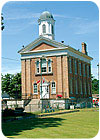
Critical environment retrofit
Today, this museum is not only the home of 12,000 artifacts but is also a research center, a cultural center, and a local landmark. After 20 years of occupying the Old Town Hall, Edinburgh Square underwent a critical environment retrofit to help protect the artifacts from deterioration. The retrofit was completed in December 2005.The museum needed to replace its aging HVAC equipment, which was operated with a timer and had become undependable over the years. Museum curator, Anne Unyi, recalled "I'd have to physically start the unit in the mornings sometimes, and the temperature would be anywhere from 14° to16°C during winter." In the summer, the temperature and humidity fluctuations were even worse, according to Unyi.
The two existing HVAC units were replaced with two new Skymark systems that control the humidity requirements of 55% rh and maintain a temperature of 22° to 24°C.
This D-B project was planned in collaboration with Haldimand County to ensure all the needs were met and the proper equipment selection was made. This system was specifically chosen because Skymark's vertical Precision unit was a good fit for the existing ducting and refrigerant piping, and therefore only the actual units had to be replaced. This was the most cost effective and efficient solution for the museum, according to Marc Provencher, the engineer and contractor from Black and McDonald Limited, the project's contracting company that provides a full range of electrical, mechanical, utility, and maintenance services to the North American and selected global markets.
Manufacturer's sales engineer Eugen Sieber commented that the application was perfect for this job "due to the ranging conditions located in each area; with the cellar being cool and damp and the office warm and dry, two independent units were the better choice."
Out of the cellar
One of the Skymark units services the cellar, where a variety of artifacts are held in storage. The project required both the removal of the old units from the basement/cellar and the outdoor condensers.The second unit controls the environment of the main floor office and museum space. Options selected for this particular job were the standard microprocessor to precisely control the temperature and humidity, steam-generating humidifier to humidify in the winter, and electric reheat to provide heat in the winter and to dehumidify in the summer.
The Skymark units are designed to fit through standard door openings to accommodate delivery. In addition, the orientation of the units can be configured for front or back return. The user friendly LCD with audible and visual alarms quickly alerts the staff to any problems and having two units in the building provides a back up in case of a maintenance shutdown. The site can also be controlled and monitored from a remote location since the units can be wired to a network monitoring system (such as a BAS) without costly add-ons.
"The new Precision system has been performing as expected, there have been consistent temperatures and humidity levels since their installation last December," said Unyi. The hydro usage has gone up slightly over 2005, but because the other units were obsolete, the new Skymark units are actually saving money as the energy efficiency is there, and while there was a slight increase in consumption from January to March, it has declined as of May of this year. The Edinburgh Square Heritage & Cultural Centre is very pleased with the new upgrades and is looking forward to showcasing their ever-growing artifact and archive collection to future generations.
